Spatial and Temporal Variations of Habitat Quality and Its Response of Landscape Dynamic in the Three Gorges Reservoir Area, China
Abstract
:1. Introduction
2. Materials and Methods
2.1. The Study Area
2.2. Evaluation Model of Habitat Quality
2.3. Data Sources and the Parameter Settings
2.4. Statistic Analysis
2.4.1. Trend Analysis
2.4.2. Correspondence Analysis
2.4.3. Hierarchical Clustering Analysis (HCA)
3. Results
3.1. Habitat Quality of the TGR Area
3.2. Spatial and Temporal Variations of the Habitat Quality
3.3. Spatial Heterogeneity of the Habitat Quality
3.4. Relationship between Landscape Dynamic and Habitat Quality
4. Discussion
4.1. Spatial and Temporal Variations of the Habitat Quality
4.2. Response of Habitat Quality on Landscape Dynamics
4.3. Enlightenments of Biodiversity Conservation
4.4. Landscape Planning for Recovering Habitat Quality
4.5. Limitations and Uncertainties
5. Conclusions
Author Contributions
Funding
Institutional Review Board Statement
Informed Consent Statement
Acknowledgments
Conflicts of Interest
References
- Hall, L.S.; Krausman, P.R.; Morrison, M.L. The habitat concept and a plea for standard terminology. Wildl. Soc. Bull. 1997, 25, 173–182. [Google Scholar]
- Cardinale, B.; Duffy, J.; Gonzalez, A.; Hooper, D.U.; Perrings, C.; Venail, P.; Narwani, A.; Mace, G.M.; Tilman, D.; Wardle, D.A.; et al. Biodiversity loss and its impact on humanity. Nature 2012, 486, 59–67. [Google Scholar] [CrossRef] [PubMed]
- Nematollahi, S.; Fakheran, S.; Kienast, F.; Jafari, A. Application of InVEST habitat quality module in spatially vulnerability assessment of natural habitats (case study: Chaharmahal and Bakhtiari province, Iran). Environ. Monit. Assess. 2020, 192, 487. [Google Scholar] [CrossRef]
- He, J.; Huang, J.; Li, C. The evaluation for the impact of land use change on habitat quality: A joint contribution of cellular automata scenario simulation and habitat quality assessment model. Ecol. Model. 2017, 366, 58–67. [Google Scholar] [CrossRef]
- Sharp, R.; Chaplin-Kramer, R.; Wood, S.; Guerry, A.; Tallis, H.; Ricketts, T.; Nelson, E.; Ennaanay, D.; Wolny, S.; Olwero, N.; et al. InVEST User’s Guide; The Natural Capital Project; Stanford University: Stanford, CA, USA; University of Minnesota: Minneapolis, MN, USA; The Nature Conservancy: Arlington County, VA, USA; World Wildlife Fund: Gland, Switzerland, 2018. [Google Scholar] [CrossRef]
- Mace, G.; Norris, K.; Fitter, A. Biodiversity and ecosystem services: A multilayered relationship. Trends Ecol. Evol. 2012, 27, 1–26. [Google Scholar] [CrossRef]
- Wardle, D. Do experiments exploring plant diversity ecosystem functioning relationships inform how biodiversity loss impacts natural ecosystems? J. Veg. Sci. 2016, 27, 646–653. [Google Scholar] [CrossRef]
- Choudhary, A.; Deval, K.; Joshi, P.K. Study of habitat quality assessment using geospatial techniques in Keoladeo National Park, India. Environ. Sci. Pollut. Res. 2021, 28, 14105–14114. [Google Scholar] [CrossRef]
- Yang, Y. Evolution of habitat quality and association with land-use changes in mountainous areas: A case study of the Taihang Mountains in Hebei Province, China. Ecol. Indic. 2021, 129, 107967. [Google Scholar] [CrossRef]
- Schwarz, N.; Moretti, M.; Bugalho, M.N.; Davies, Z.G.; Haase, D.; Hack, J.; Hof, A.; Melero, Y.; Pett, T.J.; Knapp, S. Understanding biodiversity-ecosystem service relationships in urban areas: A comprehensive literature review. Ecosyst. Serv. 2017, 27, 161–171. [Google Scholar] [CrossRef] [Green Version]
- Wu, J.; Yue, X.; Qin, W. The establishment of ecological security patterns based on the redistribution of ecosystem service value: A case study in the Liangjiang New Area, Chongqing. Geogr. Res. 2017, 36, 429–440. [Google Scholar]
- Ouyang, Z.; Liu, J.; Xiao, H.; Tan, Y.; Zhang, H. An assessment of giant panda habitat in Wolong Nature Reserve. Acta Ecol. Sin. 2001, 11, 1869–1874. [Google Scholar]
- Chu, L.; Zhang, X.; Wang, T.; Li, Z.; Cai, C. Spatial-temporal evolution and prediction of urban landscape pattern and habitat quality based on CA-Markov and InVEST model. Chin. J. Appl. Ecol. 2018, 12, 4106–4118. [Google Scholar] [CrossRef]
- Chu, L.; Sun, T.; Wang, T.; Li, Z.; Cai, C. Evolution and Prediction of Landscape Pattern and Habitat Quality Based on CA-Markov and InVEST Model in Hubei Section of Three Gorges Reservoir Area (TGRA). Sustainability 2018, 11, 3854. [Google Scholar] [CrossRef] [Green Version]
- Bai, L.; Xiu, C.; Feng, X.; Liu, D. Influence of urbanization on regional habitat quality: A case study of Changchun City. Habitat Int. 2019, 93, 102042. [Google Scholar] [CrossRef]
- Xu, L.; Chen, S.S.; Xu, Y.; Li, G.; Su, W. Impacts of Land-Use Change on Habitat Quality during 1985–2015 in the Taihu Lake Basin. Sustainability 2019, 11, 3513. [Google Scholar] [CrossRef] [Green Version]
- Berta Aneseyee, A.; Noszczyk, T.; Soromessa, T.; Elias, E. The InVEST Habitat Quality Model Associated with Land Use/Cover Changes: A Qualitative Case Study of the Winike Watershed in the Omo-Gibe Basin, Southwest Ethiopia. Remote Sens. 2020, 12, 1103. [Google Scholar] [CrossRef] [Green Version]
- Moreira, M.; Fonseca, C.; Vergílio, M.; Calado, H.; Gil, A. Spatial assessment of habitat conservation status in a Macaronesian island based on the InVEST model: A case study of Pico Island (Azores, Portugal). Land Use Policy 2018, 78, 637–649. [Google Scholar] [CrossRef]
- Huang, C.; Zhou, Z.; Peng, C.; Teng, M.; Wang, P. How is biodiversity changing in response to ecological restoration in terrestrial ecosystems? A meta-analysis in China. Sci. Total Environ. 2019, 650, 1–9. [Google Scholar] [CrossRef]
- Yudharta, B.E.; Setyaningrum, A.; Safa’Ah, O.A.; Widiasri, N.K.; Triaswanto, F.; Sukirno, S. A preliminary study of orthopterans biodiversity in the paddy fields of Sleman Regency, Special Region of Yogyakarta. IOP Conf. Ser. Earth Environ. Sci. 2021, 662, 012016. [Google Scholar] [CrossRef]
- Wu, A.; Deng, X.; Ren, X.; Xiang, W.; Zhang, L. Biogeographic patterns and influencing factors of the species diversity of tree layer community in typical forest ecosystems in China. Acta Ecol. Sin. 2018, 38, 7727–7738. [Google Scholar] [CrossRef]
- Villa, F.; Ceroni, M.; Bagstad, K.; Johnson, G.; Krivov, S. ARIES (ARtificial Intelligence for Ecosystem Services): A new tool for ecosystem services assessment, planning, and valuation. In Proceedings of the 11th Annual BIOECON Conference on Economic Instruments to Enhance the Conservation and Sustainable Use of Biodiversity, Venice, Italy, 21–22 September 2009; Available online: https://www.researchgate.net/publication/228342331 (accessed on 9 March 2022).
- Sherrouse, B.C.; Semmens, D.J. Social Values for Ecosystem Services, Version 3.0 (Solves 3.0): Documentation and User Manual; US Geological Survey: Reston, VA, USA, 2015.
- Li, Y.; Duo, L.; Zhang, M.; Wu, Z.; Guan, Y. Assessment and Estimation of the Spatial and Temporal Evolution of Landscape Patterns and Their Impact on Habitat Quality in Nanchang, China. Land 2021, 10, 1073. [Google Scholar] [CrossRef]
- Wu, J.; Huang, J.; Han, X.; Xie, Z.; Gao, X. Three-Gorges Dam—Experiment in Habitat Fragmentation? Science 2003, 300, 1239–1240. [Google Scholar] [CrossRef]
- Janse, J.; Kuiper, J.; Weijters, M.; Westerbeek, E.P.; Jeuken, M.; Bakkenes, M.; Alkemade, R.; Mooij, W.; Verhoeven, J. GLOBIO-Aquatic, a global model of human impact on the biodiversity of inland aquatic ecosystems. Environ. Sci. Policy 2015, 48, 99–114. [Google Scholar] [CrossRef] [Green Version]
- Tullos, D. Assessing the influence of Environmental Impact Assessments on science and policy: An analysis of the Three Gorges Project. J. Environ. Manag. 2009, 90 (Suppl. 3), S208–S223. [Google Scholar] [CrossRef] [PubMed]
- Wang, H.; He, M.; Ran, N.; Xie, D.; Wang, Q.; Teng, M.; Wang, P. China’s Key Forestry Ecological Development Programs: Implementation, Environmental Impact and Challenges. Forests 2021, 12, 101. [Google Scholar] [CrossRef]
- Huang, C.; Zhou, Z.; Teng, M.; Wu, C.; Wang, P. Effects of climate, land use and land cover changes on soil loss in the Three Gorges Reservoir area, China. Geogr. Sustain. 2020, 1, 200–208. [Google Scholar] [CrossRef]
- Wang, J.; Qian, Z.; Gou, T.; Mo, J.; Wang, Z.; Gao, M. Spatial-temporal changes of urban areas and terrestrial carbon storage in the Three Gorges Reservoir in China. Ecol. Indic. 2018, 95, 343–352. [Google Scholar] [CrossRef]
- Zhao, D.; Xiao, M.; Huang, C.; Liang, Y.; An, Z. Landscape Dynamics Improved Recreation Service of the Three Gorges Reservoir Area, China. Int. J. Environ. Res. Public Health 2021, 18, 8356. [Google Scholar] [CrossRef]
- Xiao, W.; Li, J.; Yu, C.; Ma, J.; Cheng, R.; Liu, S.; Wang, J.; Ge, J. Terrestrial Animal and Plant Ecology of the Three Gorges of Yangtze River; Southwest China Normal University Press: Chongqing, China, 2000. [Google Scholar]
- Huang, C.; Teng, M.; Zeng, L.; Zhou, Z.X.; Xiao, W.; Zhu, J.; Wang, P. Long-term changes of land use/cover in the Three Gorges Reservoir Area of the Yangtze River, China. J. Appl. Ecol. 2018, 29, 1585–1596. [Google Scholar] [CrossRef]
- Yao, Y. Evaluation and Dynamics Analysis of Habitat Quality Based on InVEST Model in the Sanjiang Plain. Ph.D. Thesis, University of Chinese Academy of Sciences, Changchun, China, 2017. [Google Scholar]
- Yang, S.; Zhao, W.; Liu, Y.; Wang, S.; Wang, J.; Zhai, R. Influence of land use change on the ecosystem service trade-offs in the ecological restoration area: Dynamics and scenarios in the Yanhe watershed, China. Sci. Total Environ. 2018, 644, 556–566. [Google Scholar] [CrossRef]
- Wen, Z.; Wu, S.; Chen, J.; Lü, M. NDVI indicated long-term interannual changes in vegetation activities and their responses to climatic and anthropogenic factors in the Three Gorges Reservoir Region, China. Sci. Total Environ. 2017, 574, 947–959. [Google Scholar] [CrossRef] [PubMed]
- Hill, M. Correspondence Analysis: A Neglected Multivariate Method. J. R. Stat. Soc. Ser. C Appl. Stat. 1974, 23, 340–354. [Google Scholar] [CrossRef]
- Feng, Q.; Zhao, W.; Fu, B.; Ding, J.; Wang, S. Ecosystem service trade-offs and their influencing factors: A case study in the Loess Plateau of China. Sci. Total Environ. 2017, 607, 1250–1263. [Google Scholar] [CrossRef] [PubMed]
- Sha, M.; Zhang, Z.; Gui, D.; Wang, Y.; Fu, L.; Wang, H. Data Fusion of ion Mobility Spectrometry Combined with Hierarchical Clustering Analysis for the Quality Assessment of Apple Essence. Food Anal. Methods 2017, 10, 3415–3423. [Google Scholar] [CrossRef]
- Fendereski, F.; Vogt, M.; Payne, M.R.; Lachkar, Z.; Gruber, N.; Salmanmahiny, A.; Hosseini, S.A. Biogeographic classification of the Caspian Sea. Biogeosciences 2014, 11, 6451–6470. [Google Scholar] [CrossRef] [Green Version]
- Liu, Z.; Tang, L.; Qiu, Q.; Xiao, L.; Xu, T. Temporal and spatial changes in habitat quality based on land-use change in Fujian Province. Acta Ecol. Sin. 2017, 37, 4538–4548. [Google Scholar]
- Newbold, T.; Hudson, L.N.; Hill, S.; Contu, S.; Lysenko, I.; Senior, R.; Rger, L.B.O.; Bennett, D.; Choimes, A.; Collen, B.; et al. Global effects of land use on local terrestrial biodiversity. Nature 2015, 520, 45–50. [Google Scholar] [CrossRef] [Green Version]
- Zhu, J.; Ding, N.; Li, D.; Sun, W.; Xie, Y.; Wang, X. Spatiotemporal Analysis of the Nonlinear Negative Relationship between Urbanization and Habitat Quality in Metropolitan Areas. Sustainability 2020, 12, 669. [Google Scholar] [CrossRef] [Green Version]
- Zheng, H.; Ouyang, Z.; Zhao, T.; Li, Z.; Xu, W. The impact of human activities on ecosystem services. J. Nat. Resour. 2003, 18, 118–126. [Google Scholar] [CrossRef]
- Benayas, J.; Newton, A.; Diaz, A.; Bullock, J. Enhancement of Biodiversity and Ecosystem Services by Ecological Restoration: A Meta-Analysis. Science 2009, 325, 1121–1124. [Google Scholar] [CrossRef]
- Li, Y.; Liu, C.; Min, J.; Wang, C.; Zhang, H.; Wang, Y. RS/GIS-based integrated evaluation of the ecosystem services of the Three Gorges Reservoir area (Chongqing section). Acta Ecol. Sin. 2013, 33, 168–178. [Google Scholar] [CrossRef]
- Fu, B.; Zhang, L. Land-use change and ecosystem services: Concepts, methods and progress. Prog. Geogr. 2014, 33, 441–446. [Google Scholar]
- Wang, S.; Fu, B.; Piao, S.; Lü, Y.; Ciais, P.; Feng, X.; Wang, Y. Reduced sediment transport in the Yellow River due to anthropogenic changes. Nat. Geosci. 2016, 9, 38–41. [Google Scholar] [CrossRef]
- Wilmsen, B. After the Deluge: A longitudinal study of resettlement at the Three Gorges Dam, China. World Dev. 2016, 84, 41–54. [Google Scholar] [CrossRef]
- Aerts, R.; Honnay, O. Forest restoration, biodiversity and ecosystem functioning. BMC Ecol. 2011, 11, 29. [Google Scholar] [CrossRef] [Green Version]
- Ren, H.; Li, Z.; Shen, W.; Yu, Z.; Peng, S.; Liao, C.; Ding, M.; Wu, J. Changes in biodiversity and ecosystem function during the restoration of a tropical forest in south China. Sci. China Ser. Life Sci. 2007, 50, 277–284. [Google Scholar] [CrossRef]
- Liu, C.; Wang, C. Spatio-temporal evolution characteristics of habitat quality in the Loess Hilly Region based on land use change: A case study in Yuzhong County. Acta Ecol. Sin. 2018, 38, 7300–7311. [Google Scholar] [CrossRef]
- Teng, M.; Zeng, L.; Xiao, W.; Zhou, Z.; Huang, Z.; Wang, P.; Dian, Y. Research progress on remote sensing of ecological and environmental changes in the Three Gorges Reservoir area, China. J. Appl. Ecol. 2014, 12, 3683–3693. [Google Scholar]
- Huang, C.; Yang, J.; Zhang, W. Development of ecosystem services evaluation models: Research progress. Chin. J. Ecol. 2013, 32, 3360–3367. [Google Scholar]
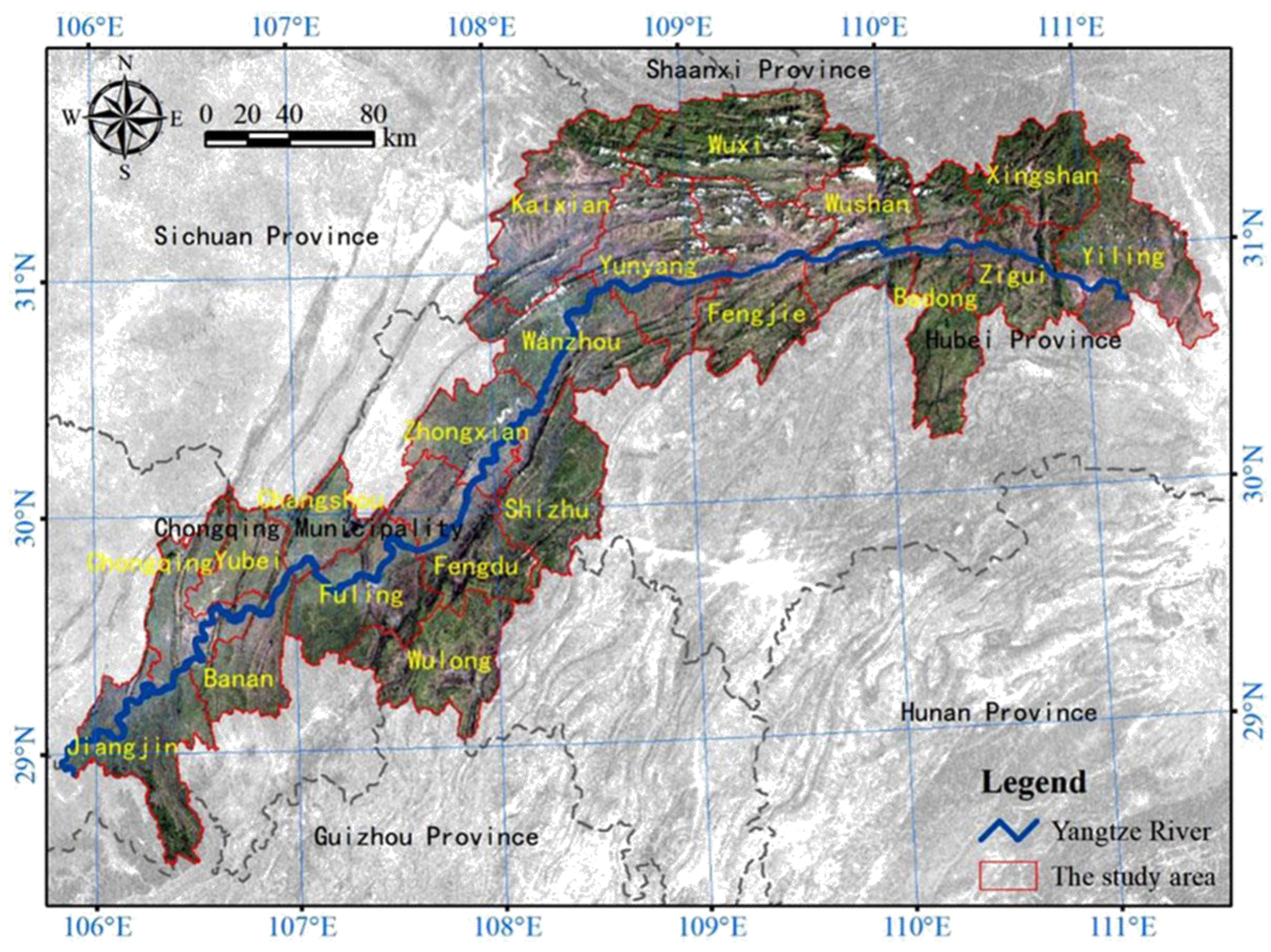
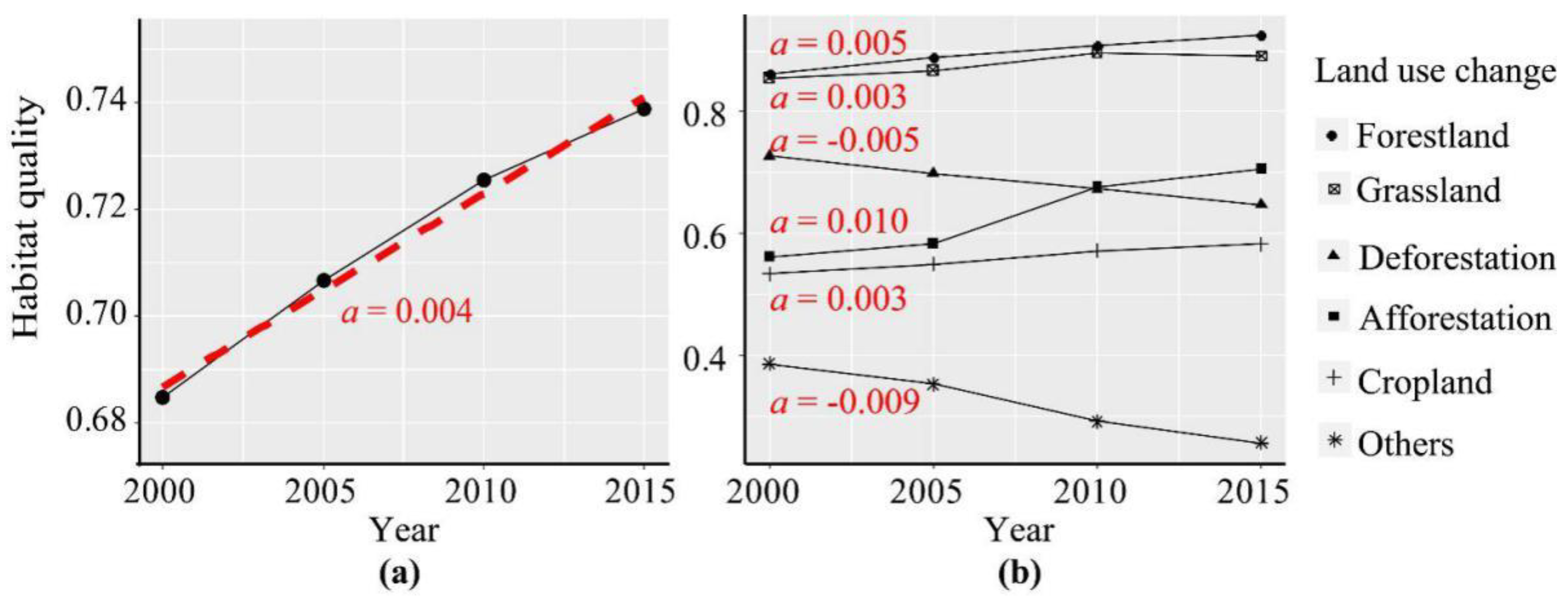

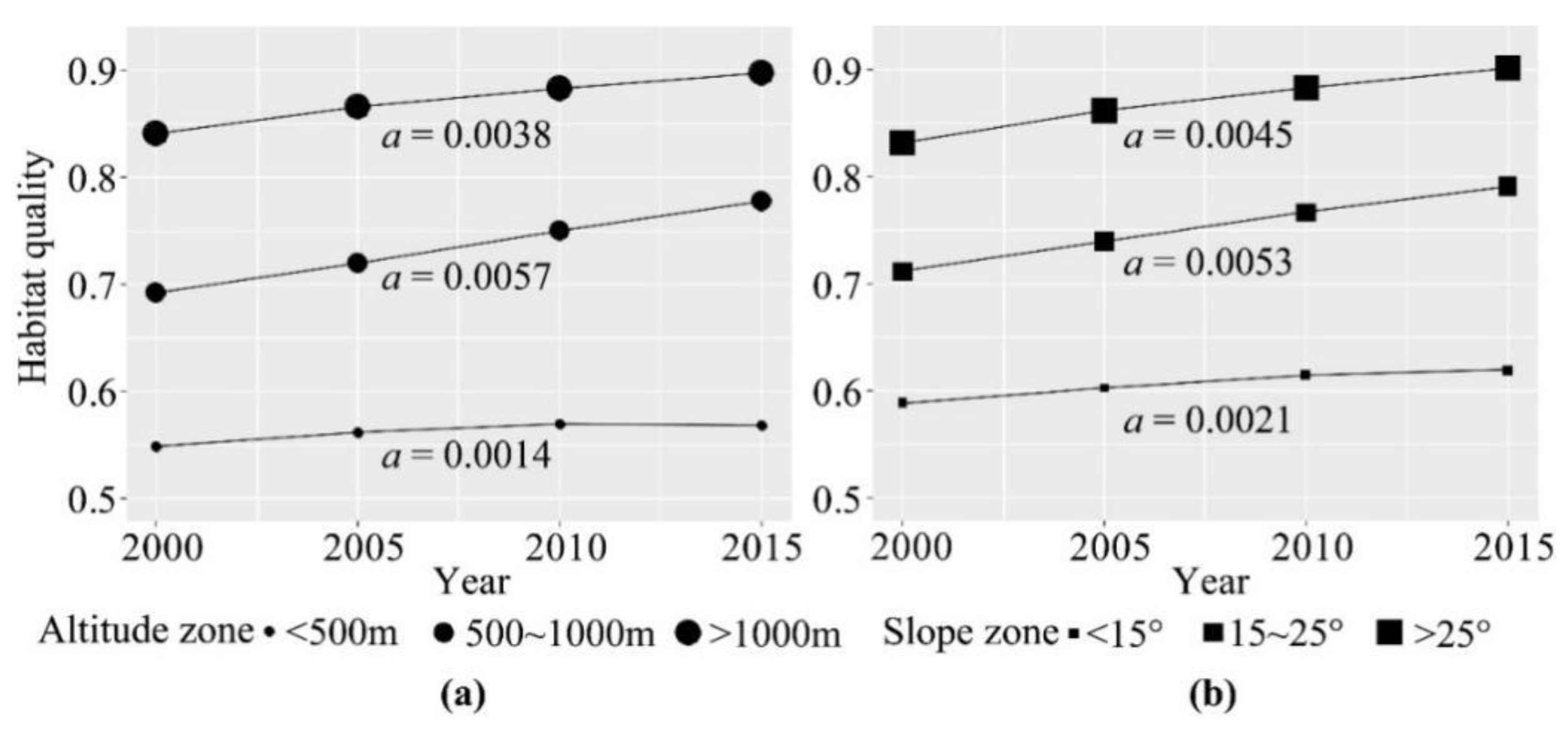
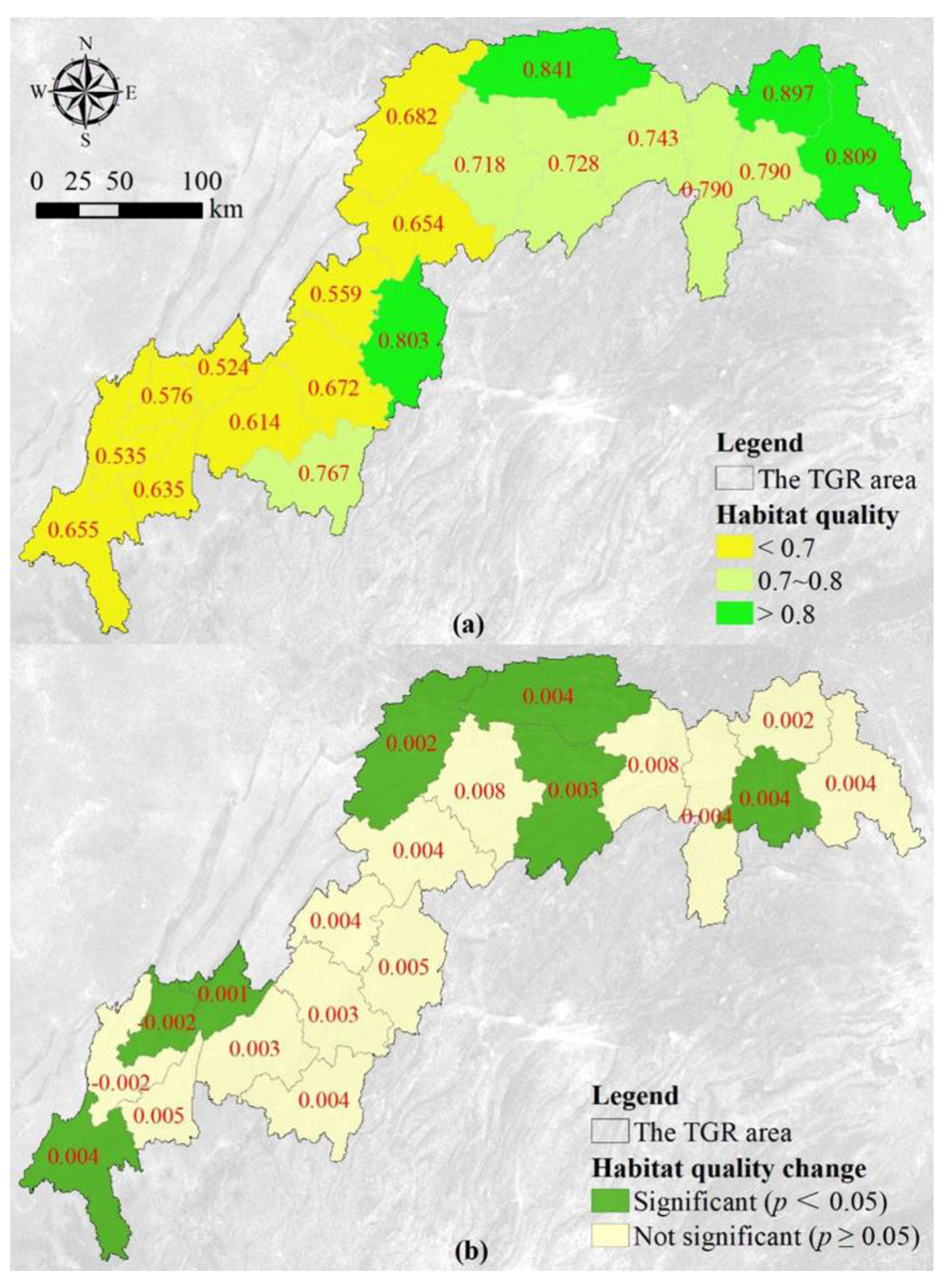


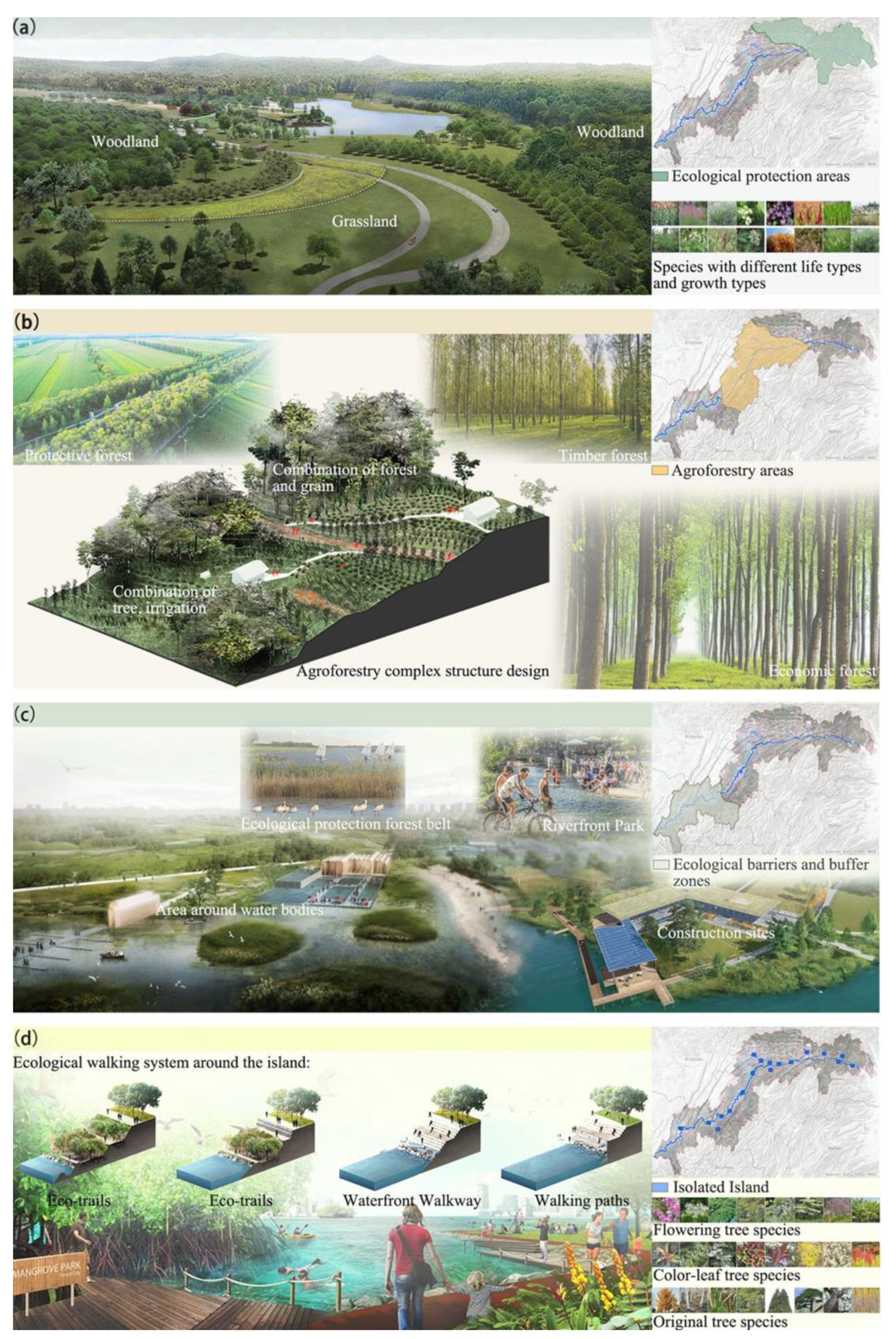
| Data | Data Sources | Description |
|---|---|---|
| Land use data | 30 m resolution land use maps were derived from Huang et al. [29]. | Land use maps with nine land use types (coniferous forest, broadleaf forest, mixed forest, shrub, grassland, cropland, water, built-up land, and bare land) of the TGR area in 2000, 2005, 2010 and 2015. |
| DEM data | 30 m resolution DEM data were derived from ASTER Global Digital Elevation Model V002 (http://www.gscloud.cn/, accessed on 13 November 2018). | DEM was used to identify the elevation and slope of the TGR area, and to generate altitude zones and slope zones. |
| Railway data | National Geomatics Center of China (NGCC) (http://ngcc.sbsm.gov.cn/, accessed on 13 November 2018). | Railways within the TGR area in 2000, 2005, 2010 and 2015. |
| Highway data | National Geomatics Center of China (NGCC) (http://ngcc.sbsm.gov.cn/, accessed on 13 November 2018). | Highways within the TGR area in 2000, 2005, 2010 and 2015. |
| National road data | National Geomatics Center of China (NGCC) (http://ngcc.sbsm.gov.cn/, accessed on 13 November 2018). | National roads within the TGR area in 2000, 2005, 2010 and 2015. |
| Traffic station data | Points of tourist attractions were acquired from Baidu maps. | Traffic stations within the TGR area in 2000, 2005, 2010 and 2015. |
| Hotel data | Points of hotels were acquired from Baidu maps. | Hotels within the TGR area in 2000, 2005, 2010 and 2015. |
| Tourist attraction data | Points of traffic stations were acquired from Baidu maps. | Tourist attractions within the TGR area in 2000, 2005, 2010 and 2015. |
| Threat Factor | Data Type | Maximum Distance | Decay Type | Weight |
|---|---|---|---|---|
| Railway | Linear vector data | 1 km | Exponential distance-decay function | 0.5 |
| Highway | Linear vector data | 2 km | Exponential distance-decay function | 0.8 |
| National road | Linear vector data | 1 km | Exponential distance-decay function | 0.8 |
| Traffic station | Point vector data | 10 km | Linear distance-decay function | 1 |
| Hotel | Point vector data | 5 km | Linear distance-decay function | 0.7 |
| Tourist attraction | Point vector data | 3 km | Linear distance-decay function | 0.6 |
| Built-up area | Raster data | 10 km | Exponential distance-decay function | 1 |
| Water | Raster data | 1 km | Linear distance-decay function | 0.3 |
| Cropland | Raster data | 4 km | Linear distance-decay function | 0.5 |
| Land Use Type | Habitat Score | The Relative Sensitivity of Each Habitat Type to Each Threat | ||||||||
|---|---|---|---|---|---|---|---|---|---|---|
| Railway | Highway | National Road | Hotel | Traffic Station | Tourist Attraction | Built-up Area | Water | Crop Land | ||
| Coniferous forest | 1 | 0.6 | 0.7 | 0.8 | 0.8 | 0.9 | 0.5 | 0.9 | 0.8 | 0.5 |
| Broadleaf forest | 1 | 0.6 | 0.7 | 0.8 | 0.8 | 0.9 | 0.5 | 0.9 | 0.8 | 0.5 |
| Mixed forest | 1 | 0.6 | 0.7 | 0.8 | 0.8 | 0.9 | 0.5 | 0.9 | 0.8 | 0.5 |
| Shrub | 1 | 0.3 | 0.3 | 0.3 | 0.3 | 0.3 | 0.3 | 0.4 | 0.5 | 0.75 |
| Grassland | 0.8 | 0.6 | 0.7 | 0.8 | 0.5 | 0.5 | 0.5 | 0.5 | 0.5 | 0.75 |
| Cropland | 0.5 | 0.6 | 0.8 | 0.8 | 0.5 | 0.9 | 0.5 | 1 | 0.8 | 0.75 |
| Water | 0 | 0 | 0 | 0 | 0 | 0 | 0 | 0 | 0 | 0 |
| Built-up land | 0 | 0 | 0 | 0 | 0 | 0 | 0 | 0 | 0 | 0 |
| Bare land | 0 | 0 | 0 | 0 | 0 | 0 | 0 | 0 | 0 | 0 |
Publisher’s Note: MDPI stays neutral with regard to jurisdictional claims in published maps and institutional affiliations. |
© 2022 by the authors. Licensee MDPI, Basel, Switzerland. This article is an open access article distributed under the terms and conditions of the Creative Commons Attribution (CC BY) license (https://creativecommons.org/licenses/by/4.0/).
Share and Cite
Liu, S.; Liao, Q.; Xiao, M.; Zhao, D.; Huang, C. Spatial and Temporal Variations of Habitat Quality and Its Response of Landscape Dynamic in the Three Gorges Reservoir Area, China. Int. J. Environ. Res. Public Health 2022, 19, 3594. https://doi.org/10.3390/ijerph19063594
Liu S, Liao Q, Xiao M, Zhao D, Huang C. Spatial and Temporal Variations of Habitat Quality and Its Response of Landscape Dynamic in the Three Gorges Reservoir Area, China. International Journal of Environmental Research and Public Health. 2022; 19(6):3594. https://doi.org/10.3390/ijerph19063594
Chicago/Turabian StyleLiu, Shuangshuang, Qipeng Liao, Mingzhu Xiao, Dengyue Zhao, and Chunbo Huang. 2022. "Spatial and Temporal Variations of Habitat Quality and Its Response of Landscape Dynamic in the Three Gorges Reservoir Area, China" International Journal of Environmental Research and Public Health 19, no. 6: 3594. https://doi.org/10.3390/ijerph19063594
APA StyleLiu, S., Liao, Q., Xiao, M., Zhao, D., & Huang, C. (2022). Spatial and Temporal Variations of Habitat Quality and Its Response of Landscape Dynamic in the Three Gorges Reservoir Area, China. International Journal of Environmental Research and Public Health, 19(6), 3594. https://doi.org/10.3390/ijerph19063594







